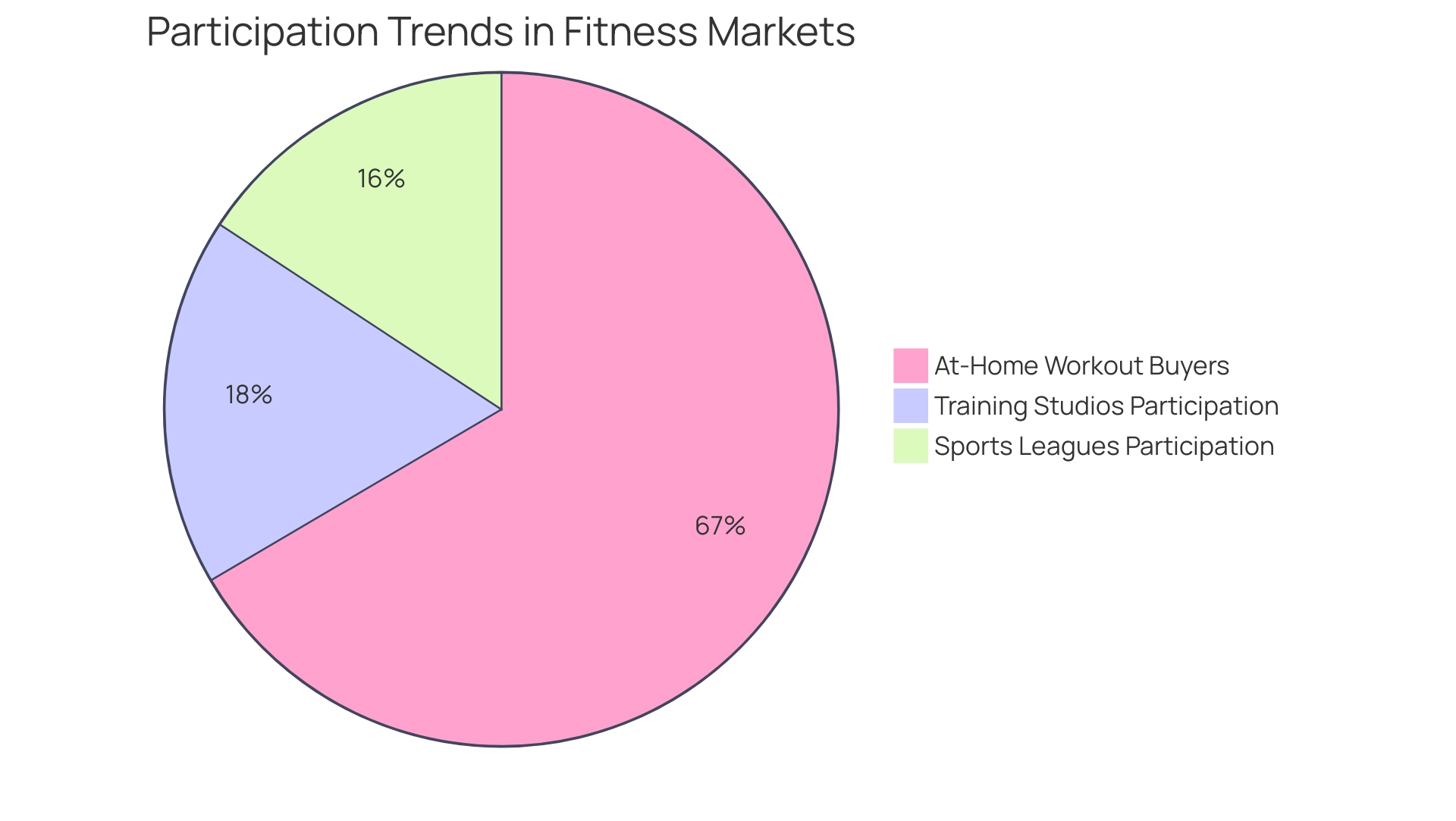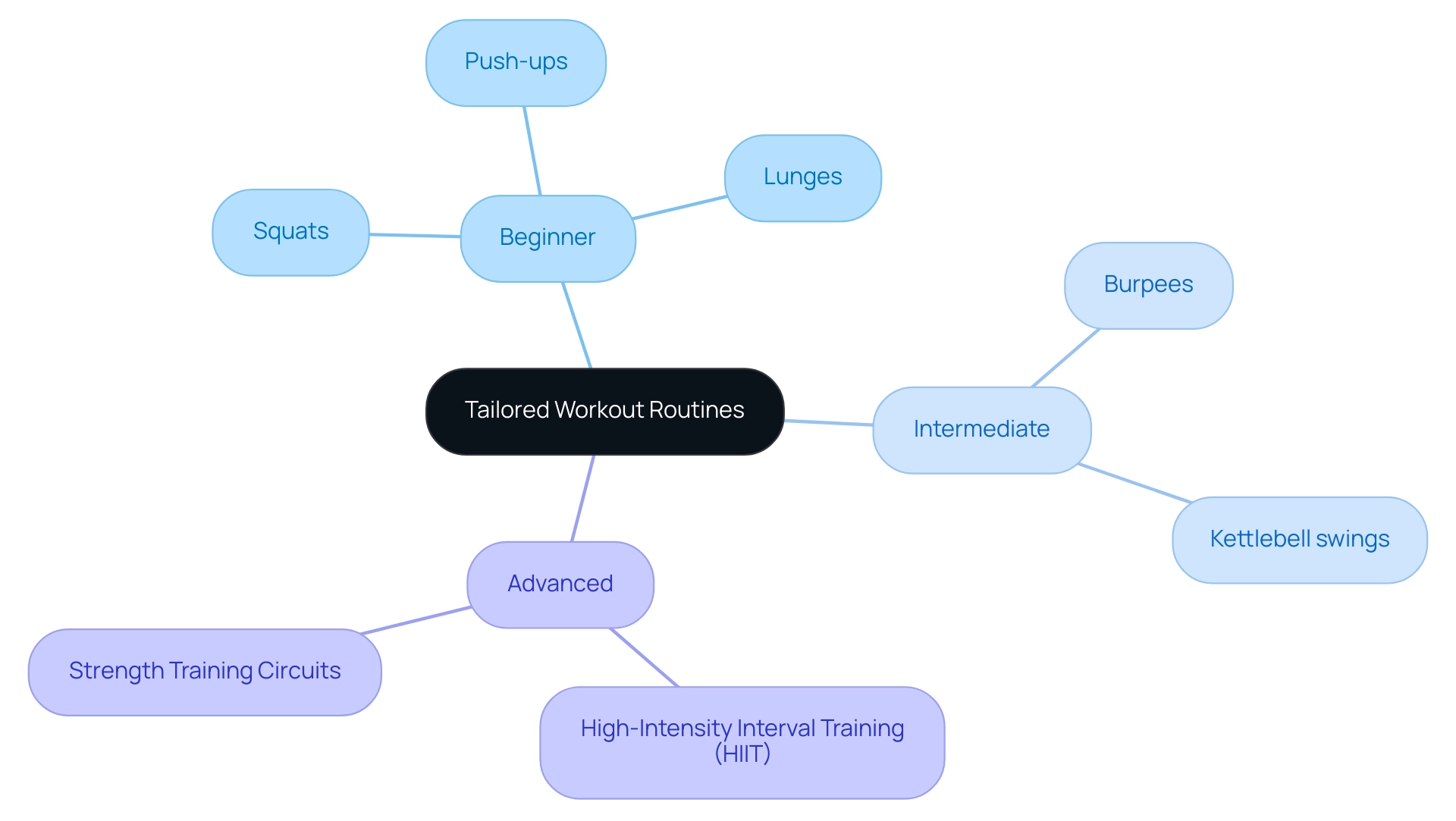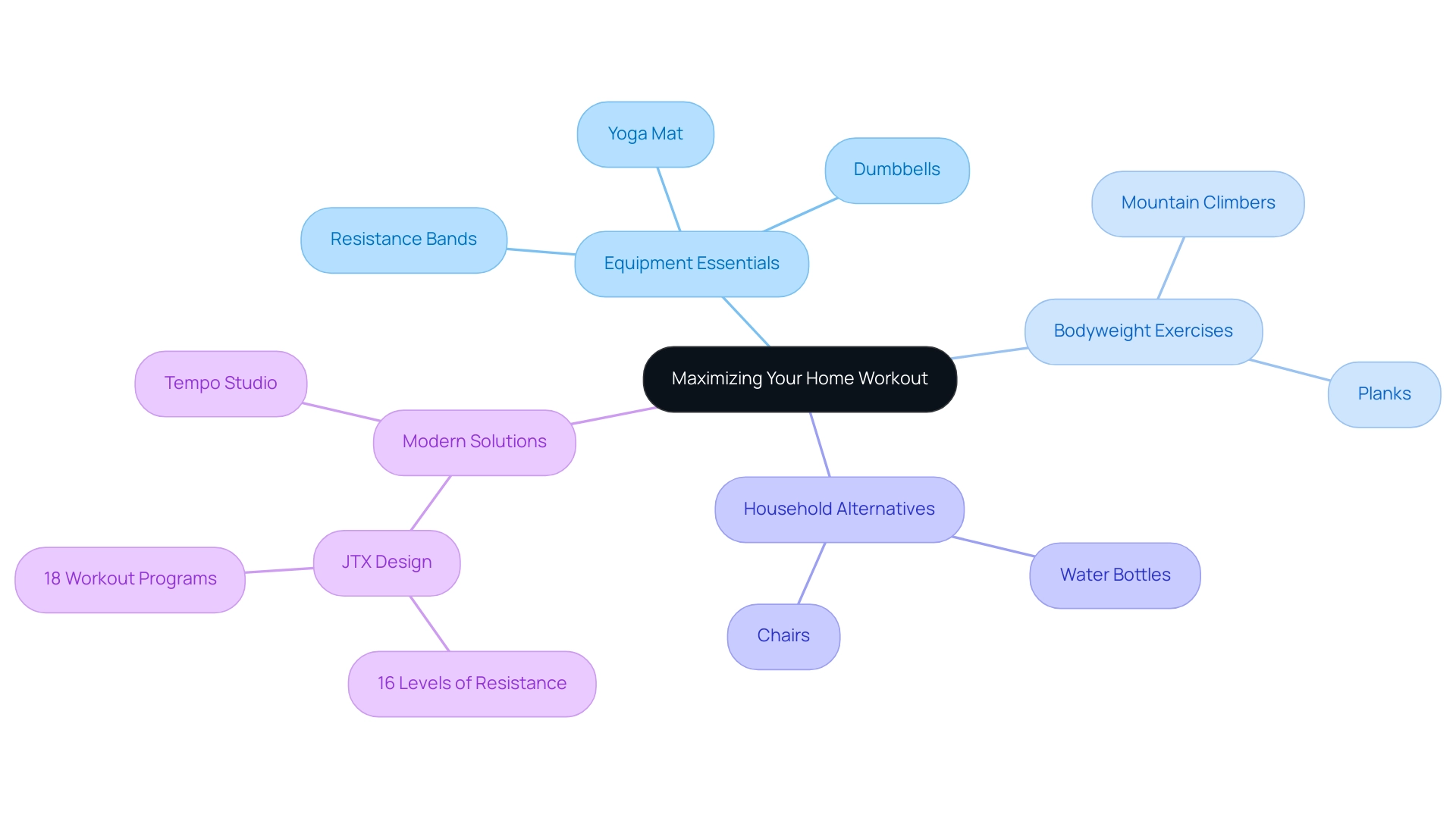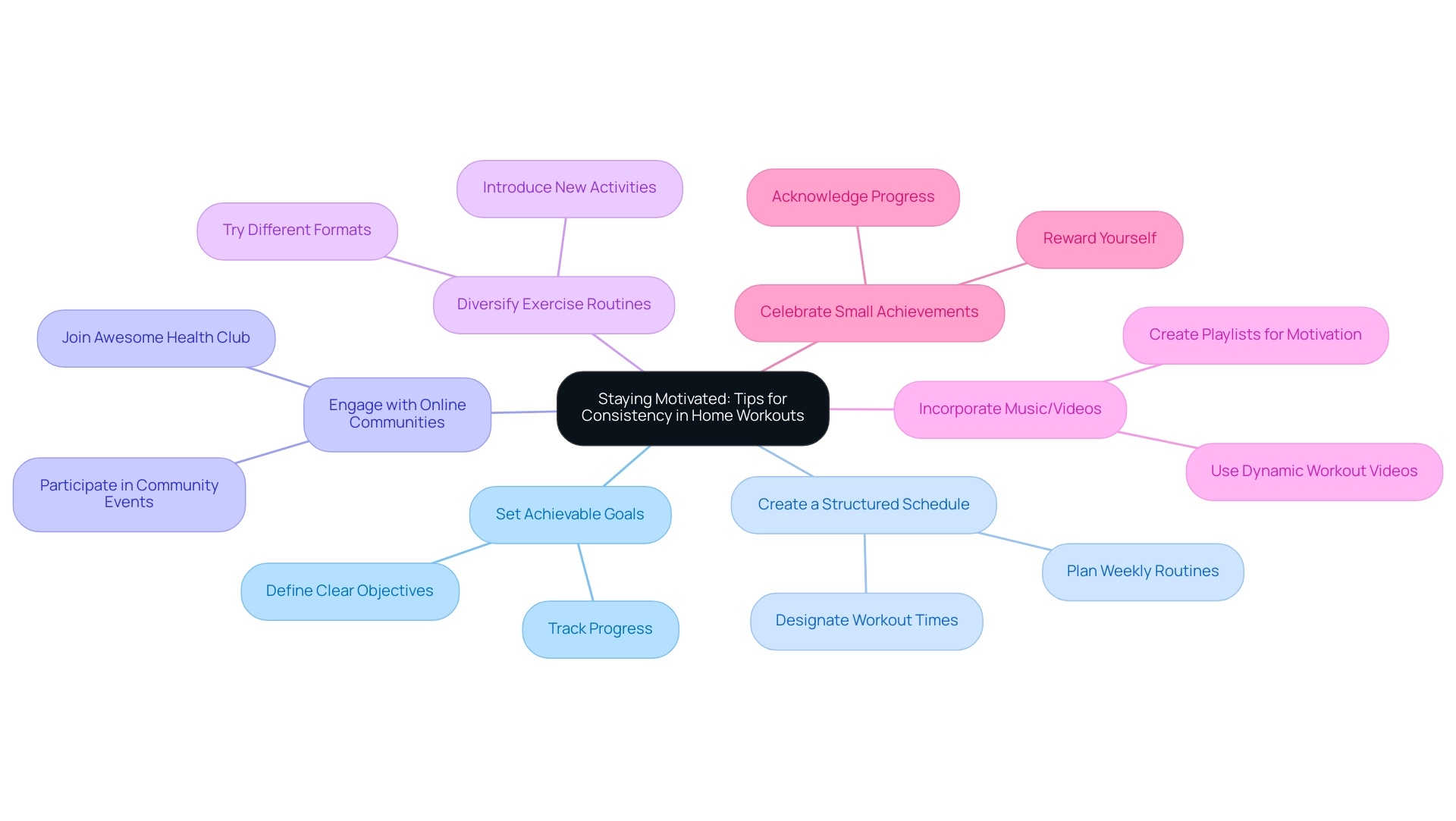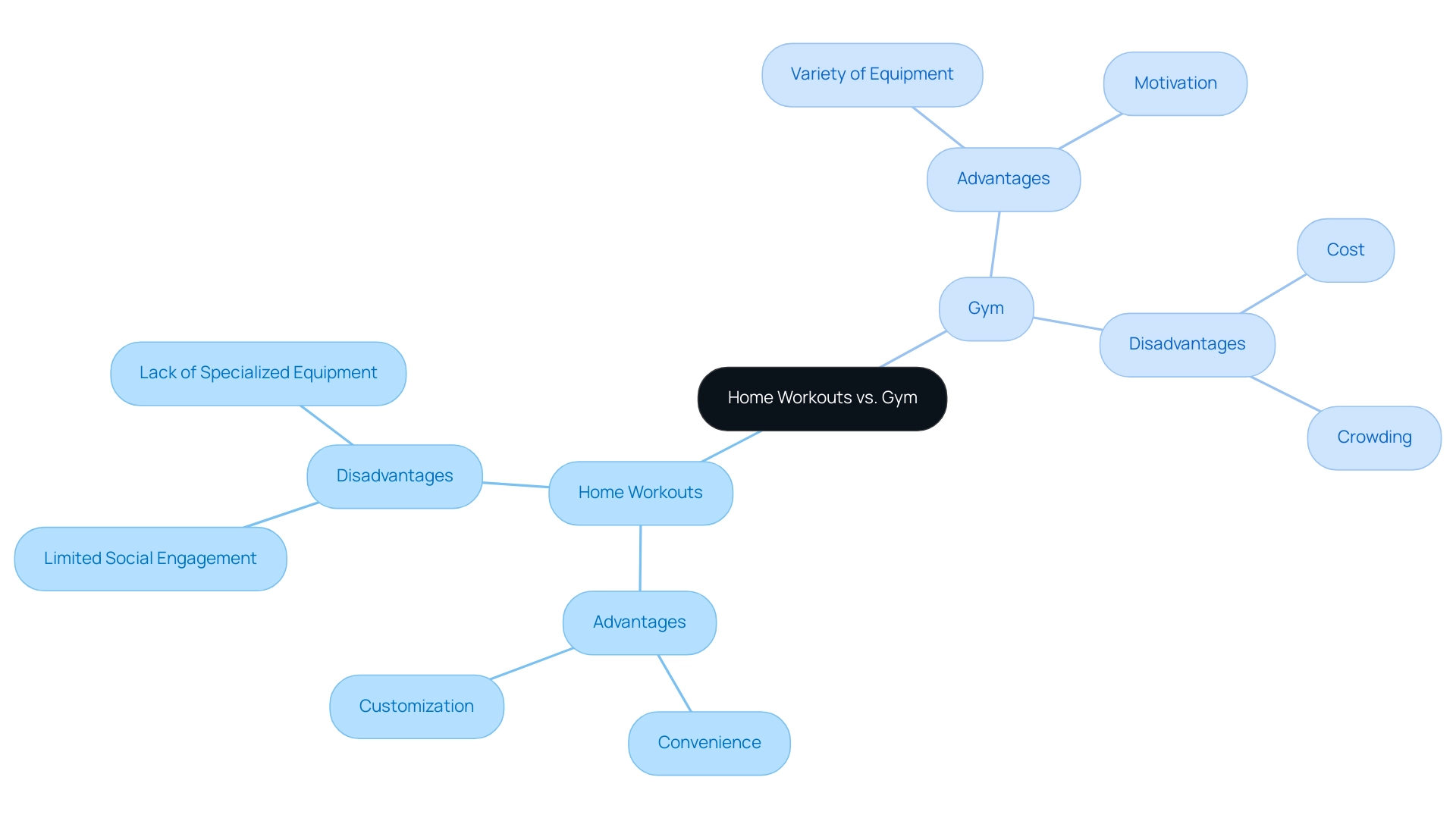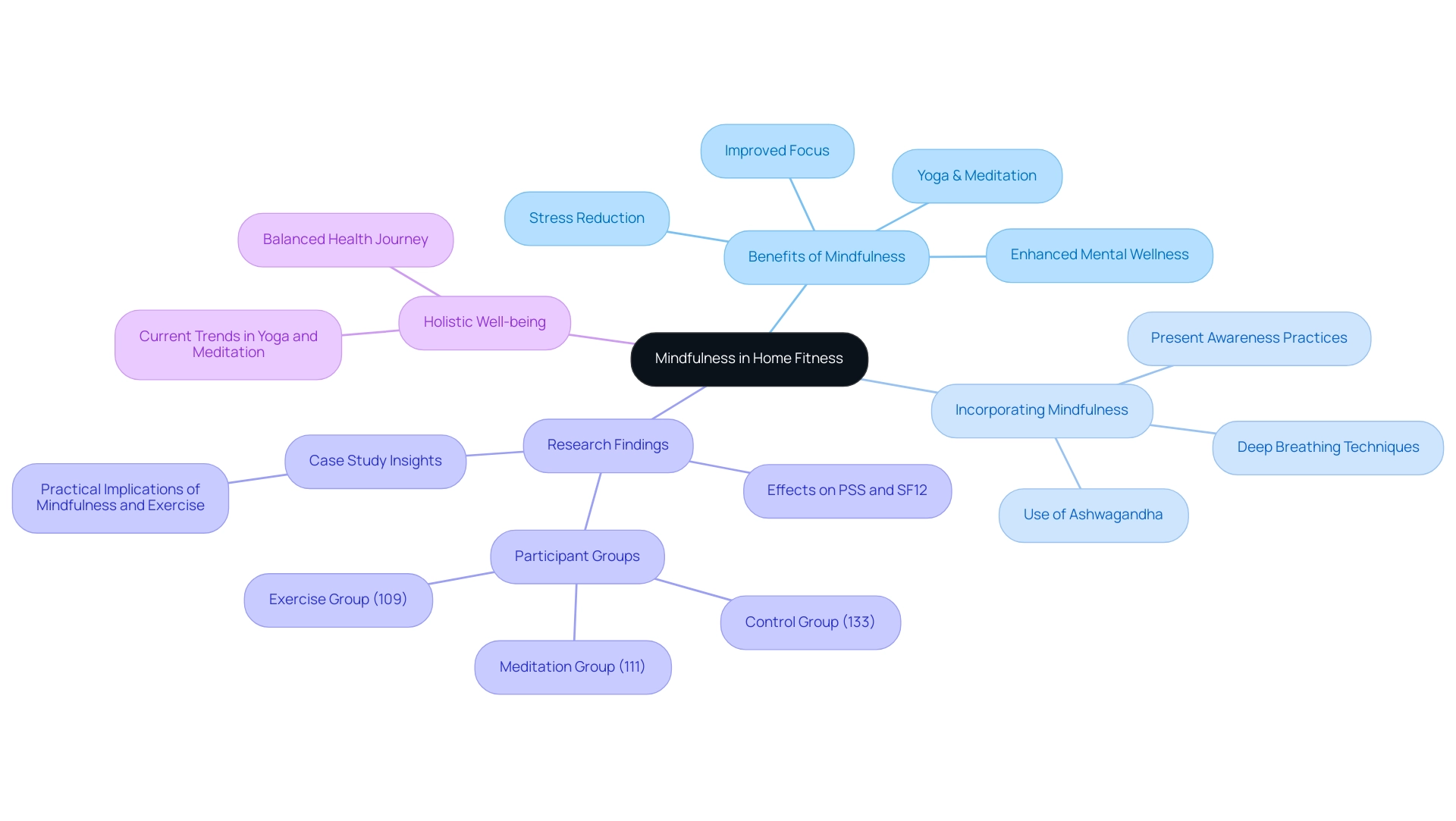Introduction
The evolution of fitness has taken a significant turn, with at-home workouts emerging as a preferred choice for many. This shift is not merely a response to convenience; it reflects a broader trend towards inclusivity in fitness, catering to individuals across all levels of experience.
As traditional gym attendance declines, the accessibility of home workouts has empowered a diverse range of people to embrace physical activity on their own terms. From tailored routines that accommodate beginners to advanced techniques for seasoned athletes, the landscape of fitness is rapidly changing.
This article explores the various facets of at-home workouts, including:
- Essential equipment
- Motivational strategies
- The integration of mindfulness
Ultimately, it highlights the profound impact these practices have on overall well-being.
1. The Rise of At-Home Workouts: Accessibility for All Fitness Levels
The increase in at home workouts has changed physical activity routines, influenced by their convenience and flexibility. In 2020, people aged 26-35 represented the largest portion of the exercise equipment market, accounting for 33.8% of buyers. This trend has only intensified, with data indicating that
exercises in training studios and sports leagues have decreased to 9% and 8%, respectively, in 2023, as more individuals adopt at home workouts instead of going to gyms.
The ability to participate in at home workouts accommodates the busy lives of many, particularly in the context of remote work. Such exercises cater to all fitness levels, empowering beginners to embark on their fitness journeys without the intimidation often felt in traditional gym environments, while also providing seasoned athletes with advanced routines. The adaptability intrinsic to at home workouts allows people to effortlessly integrate physical activity into their daily routines, promoting a healthier lifestyle without the requirement of a gym membership.
On average, Americans dedicate approximately 0.31 hours each day to sports, exercise, and recreation, demonstrating how at home workouts can be integrated into overall physical activity levels. As Tyler Read, a certified personal trainer with over 15 years of experience, observes, at home workouts can effectively satisfy the requirements of various individuals, making health more attainable for everyone. This accessibility is crucial, especially in light of ongoing challenges many Americans face in maintaining regular physical activity, as outlined in the case study titled 'Challenges to Maintaining Physical Activity.'
The present environment of exercise reflects a notable transition towards at home workouts, emphasizing continuous endeavors to enhance accessibility and generate more chances for physical activity, and showcasing the wider advantages of participating in at home workouts.
2. Tailored Workout Routines: Finding the Right Fit for Your Level
Choosing the appropriate workout routine, especially at home workouts, is crucial for both safety and effectiveness, particularly for beginners. Bodyweight exercises, including:
provide an excellent foundation for at home workouts for those who are new to exercising. As people progress to an intermediate level, they may incorporate more complex movements like:
- Burpees
- Kettlebell swings
Advanced exercise enthusiasts can further challenge themselves with:
- High-intensity interval training (HIIT)
- Strength training circuits
Customizing exercise routines to suit one’s physical capability not only enhances motivation but also fosters a deep sense of accomplishment as people observe their advancement. This method is especially crucial in underserved communities, where access to exercise centers and secure outdoor areas may be restricted, as highlighted by wellness advocate Aishwarya Mehra:
'Access to exercise centers and secure outdoor areas can also be a limiting factor, particularly in underserved communities.'
By concentrating on tailored exercise plans, individuals of varying activity levels can effectively improve their physical engagement and overall well-being with at home workouts. Moreover, statistics show that of the 37 customized physical activity interventions identified, 10 involved knowledge users in some aspect of intervention design, highlighting the effectiveness of personalized approaches in promoting well-being.
3. Maximizing Your Home Workout: Equipment Essentials and Alternatives
Contrary to the widespread notion that attaining efficient exercise routines requires a fully outfitted gym, the truth is that significant fitness improvements can be achieved through at home workouts with limited gear. As a certified personal trainer and nutrition coach, Anthony O'Reilly emphasizes that essential items for exercising indoors typically include:
- Resistance bands
- Dumbbells
- A yoga mat
However, it’s important to recognize the power of bodyweight exercises. Movements such as planks and mountain climbers are not only efficient for building strength but also enhance endurance without any equipment.
Additionally, everyday household items—such as water bottles or strong chairs—can act as excellent alternatives for increased resistance or support, further illustrating that effective exercises can be accomplished in the comfort of one’s residence. This philosophy is reflected in the
'Exercise is Medicine' initiative, which promotes the incorporation of physical activity in medical care, emphasizing how fitness centers and at home workouts can collectively enhance community health.
Furthermore, the JTX design provides 16 levels of resistance and 18 exercise programs, highlighting the versatility of fitness equipment.
Modern solutions such as Tempo Studio, equipped with a large touchscreen and a range of exercise classes, further demonstrate the progress of at home workouts.
4. Staying Motivated: Tips for Consistency in Home Workouts
Sustaining enthusiasm during exercise sessions depends on setting achievable health objectives and carefully monitoring advancement. Creating a structured exercise schedule lays the groundwork for a consistent routine, and engaging with online fitness communities, like Awesome Health Club, fosters a sense of support and accountability among health enthusiasts. To enhance your at-home workouts, consider incorporating affordable dumbbells and kettlebells, which offer versatile options for strength training.
Recent studies indicate that online interactions significantly bolster
exercise consistency, making them an invaluable resource for members. It's important to acknowledge that access to fitness facilities and safe outdoor spaces remains a barrier, particularly in underserved communities, impacting individuals' ability to stay active. Moreover, statistics show that 85% of those aged 60 and older choose overall health and wellness as a main motivator, highlighting the need for tailored approaches across different age groups.
To combat monotony, diversifying exercise routines by introducing new activities or formats keeps engagement levels high. Incorporating music or utilizing dynamic workout videos can enhance the overall experience, transforming exercise into a more enjoyable activity. Celebrating small achievements not only reinforces positive habits but also sustains motivation over the long term, creating a fulfilling and productive fitness journey.
As Maren Hale, an advocate for sustainable eating and holistic health, emphasizes, 'Motivation is about finding joy in the journey and surrounding yourself with supportive communities.' Join Awesome Health Club today to connect with like-minded people and discover community events that can further support your wellness journey.
5. Home Workouts vs. Gym: Weighing the Pros and Cons
When considering the choices of personal exercise routines versus gym sessions, both options offer distinct benefits and disadvantages. At home workouts are praised for their remarkable convenience and adaptability, enabling people to customize their fitness routines to suit their own schedules and tempo. This approach is particularly appealing to younger adults; as Emily Goodwin notes,
Intent to purchase equipment is also highest among adults aged 18-34.
Nonetheless, working out at one's residence may have constraints, such as insufficient social engagement and reduced availability of specialized apparatus that can frequently improve exercise efficacy. Conversely, fitness centers provide a varied selection of machines and classes that can greatly increase motivation and accountability, crucial elements for numerous people aiming to achieve their fitness objectives. Furthermore, high-quality gym apparatus is engineered for durability, which can alleviate some maintenance issues linked to personal exercise routines.
Recent studies show that 32 percent of all consumer statements regarding gym use are neutral, indicating a mix of satisfaction and dissatisfaction among gym-goers. This implies that although gyms offer important resources, they also pose obstacles that could discourage certain users.
Insights from consumer studies indicate that some people may not be utilizing their personal equipment efficiently, raising questions about their exercise selections and satisfaction levels. Ultimately, the
choice between at home workouts and gym sessions is a personal matter, shaped by individual preferences, health goals, and lifestyle considerations. As consumers increasingly evaluate the dynamics of at-home exercise versus traditional gym environments, understanding these trade-offs becomes crucial for informed decision-making in the pursuit of a sustainable wellness routine.
6. Incorporating Mindfulness into Your Home Fitness Routine
Incorporating mindfulness into at home workouts can significantly enhance both the experience and the benefits of physical activity. Research involving 109 participants in the exercise group and 111 in the meditation group indicates that practices such as yoga and meditation not only improve focus but also significantly reduce stress levels. This connection between the mind and body fosters a deeper engagement during at home workouts.
For instance, even within traditional exercise routines, at home workouts that include moments to breathe deeply and maintain present awareness can amplify the effectiveness of each session. Additionally, incorporating ashwagandha into your routine may further support these mindfulness practices by reducing cortisol levels and promoting a sense of calm, enhancing overall mental wellness. Dr. Jeffrey A. Hayes, a proponent of mindfulness, emphasizes its transformative potential, stating that 'virtually every client and therapist would benefit from being more mindful.'
Moreover, findings from the case study titled '
Practical Implications of Mindfulness and Exercise' suggest that both mindfulness and exercise practices serve as effective stress reducers and enhancers of well-being. By prioritizing mental health alongside physical fitness, individuals can embark on a more balanced and fulfilling health journey, reflecting current trends in yoga and meditation that emphasize holistic well-being.
Conclusion
The shift towards at-home workouts signifies a monumental change in the fitness landscape, driven by the need for accessibility and flexibility. As traditional gym attendance declines, individuals are increasingly embracing home-based routines that cater to all fitness levels. This transformation not only accommodates busy lifestyles but also empowers individuals to embark on their fitness journeys without the intimidation often associated with gyms.
Tailored workout routines are essential for maximizing the benefits of at-home fitness. By focusing on exercises that match personal abilities, individuals can safely progress in their fitness levels, fostering motivation and a sense of achievement. Moreover, the availability of minimal equipment and the innovative use of everyday household items highlight that effective workouts do not require a fully equipped gym.
Staying motivated in a home workout setting involves:
- Setting realistic goals
- Tracking progress
- Engaging with supportive communities
The incorporation of mindfulness practices further enriches the workout experience, enhancing both physical and mental well-being. Ultimately, the choice between home workouts and gym sessions should be guided by personal preferences and fitness objectives, as both offer unique advantages.
By embracing the diverse opportunities presented by at-home workouts, individuals can cultivate a healthier lifestyle that aligns with their personal circumstances. This evolution in fitness not only promotes physical activity but also fosters a sense of community and well-being, ensuring that everyone can find their path to a fulfilling fitness journey.
